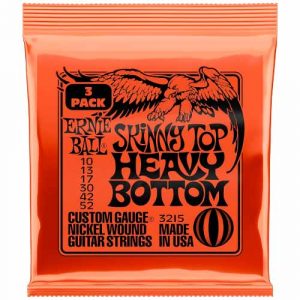Our top pick famous guitarists string gauges for you to try
Introduction
Welcome to the string-slinging saga of the century, where we unravel the twisted tales of ‘famous guitarists string gauges.’ Ever wondered why Jimi Hendrix’s solos feel like a gentle caress one moment and a thunderstorm the next? Or how Stevie Ray Vaughan’s strings survived his ferocious playing?
It’s all in the gauges, my friends. Join us on this journey through the wires of history, as we dig into what makes or breaks the sound of a guitar legend. Whether you’re a six-string slinger or a curious cat with an ear for music, there’s something in the string soup for everyone. Let’s pluck our way through, shall we?
Why String Gauge Matters
Imagine playing tug-of-war with dental floss. Now imagine it with a rope. That’s string gauge in a nutshell. The thickness of your guitar strings can dramatically affect everything from the tone to how your fingers feel after a three-hour jam session.
Thicker strings (“ropes”) can give you a beefier tone, perfect for blues and rock. Lighter strings (“dental floss”), on the other hand, are easier on the fingers and ideal for fast solos and bends. It’s the difference between a steak dinner and a light salad – both satisfying, but for different appetites.
Historical Context of String Gauges
In the past, guitarists had limited options when it came to strings, often resorting to improvising with whatever materials they could find, such as telephone wires, to create music. This era could be characterized by the motto “use whatever you can find.” As the musical landscape transformed, particularly with the electric guitar revolution of the 1950s and 1960s, there emerged a significant shift towards customization in string gauges.
This period marked the beginning of a renaissance in string gauge preferences, with famous guitarists like Hendrix and Clapton leading the charge in the quest for the ultimate tone. The evolution of string gauges has since allowed guitarists to refine their sound with precision, highlighting the importance of famous guitarists string gauges in the development of music.
Jimi Hendrix: Experimenting with Lighter Gauges
Jimi Hendrix, the wizard of the six-string, was known for his spellbinding sound and otherworldly playing technique. What’s less known is his preference for lighter string gauges.
This choice allowed Hendrix to bend the strings to his will, literally, achieving those cosmic vibratos and soul-piercing bends. Lighter strings were a part of his sonic toolkit, enabling him to explore the guitar’s melodic potential fully. Let’s look at some other famous guitarists string gauges.
Stevie Ray Vaughan: Pushing the Limits with Heavy Strings
On the flip side of the string spectrum, we have Stevie Ray Vaughan. If Hendrix’s strings were whispers, Vaughan’s were roars. Known for using gauges as thick as .013 to .058, Stevie pushed his strings as hard as they pushed back, resulting in a raw, powerful tone that became his signature. It’s said that playing his guitar was like wrestling with a bear. Only Stevie could tame such a beast.
Eddie Van Halen: Finding Balance
Eddie Van Halen, renowned for his ability to make a guitar express a wide range of emotions, discovered his ideal sound with a medium gauge, specifically ranging from .009 to .011 for his high E string. This choice in famous guitarists’ string gauges allowed him the versatility required for his revolutionary tapping techniques, while also ensuring a rich, full-tone
Eddie’s approach to his setup reflected his relentless pursuit of innovation, constantly adjusting and experimenting to achieve the perfect sound. His preference serves as a reminder of the magic found in balance, akin to finding the perfect level of spiciness for your taco—neither too mild nor too overpowering, but just right to elevate every bite into a culinary delight.
Jimmy Page: Mixing Gauges for Versatility
The architect of Led Zeppelin’s monumental sound, Jimmy Page, was a master of musical alchemy. His secret? A custom mix of string gauges, tailored to suit his multifaceted playing style. By combining lighter gauges on top with heavier ones on the bottom, Page crafted a setup that allowed for delicate fingerpicking and thunderous riffing alike. This custom approach is akin to having your cake and eating it too—a sonic smorgasbord that enabled Page to explore the vast landscape of sound that defines Led Zeppelin’s discography.
Play bass as well? Take a look at our review of the top bass strings for slap.
Eric Clapton: The Pursuit of Tone
Eric Clapton’s journey through string gauges is a narrative of his evolution as a musician. From the beefier strings of his blues-driven days with Cream to the lighter touch required for his solo ballads, Clapton’s choice of string gauge has mirrored his musical journey. Clapton has used a variety of strings throughout his career; from strings creating the best clean tones to strings that give heavier, crunchier sounds.
Often settling around a .010 to .046 set, Clapton’s preference leans towards a balance, offering enough resistance for a biting blues tone while still allowing for the expressive bends and vibrato that color his slower, emotive solos. Clapton’s string choices underscore the importance of adapting one’s gear to their evolving artistic expression. Here are some more famous guitarists string gauges.
B.B. King: The Light Touch
The king of blues, B.B. King, with Lucille in his hands, opted for lighter gauges, usually around .010 to .054. This setup facilitated his signature vibrato and the fluidity of his playing. King’s lighter touch and the expressive nuance of his playing highlight how string gauge can be tailored to accentuate the nuances of one’s playing style. B.B. King’s approach to strings and light guitars shows that sometimes, the lightest touch can carry the most profound emotion.
Slash: Sustaining Heavy Tones
Slash, the top-hatted maestro behind Guns N’ Roses’ riffs, opts for a slightly heavier set, typically .011 to .048. This choice supports his thick, sustained tones and hard-hitting solos that define tracks like “Sweet Child o’ Mine.” Slash’s preference demonstrates the role of string gauge in achieving sustained distortion and a fuller sound, crucial for the hard rock genre. It’s like choosing a four-wheel drive for off-road adventures—the right equipment makes all the difference in navigating the rugged terrain of rock music.
The Secret Sauce: Guitar String Thickness
In the quest for the ultimate tone, the gauges of famous guitarists string choices are crucial. Thicker strings are celebrated for delivering a richer, more resonant tone, perfect for creating those deep blues or powerful rock rhythms. Conversely, thinner strings are favored by shredders and fast riff enthusiasts for their ease of play and brighter tone.
This delicate balance between string gauge and musical expression is something that our guitar legends navigate with remarkable precision, showcasing the significant impact of famous guitarists’ string gauges on their iconic sounds.
Feeling the Tension: String Tension and Tone
String tension isn’t just about how hard it is to push the strings down—it’s about the tone. Higher tension strings can give you a sound that’s tight and coherent, perfect for genres that require crisp, clear notes. Lower tension strings, meanwhile, offer a softer, more mellow tone. It’s all about matching the tension to your musical expression, a lesson well-taught by the legends.
Style Meets String: Best Strings for Playing Style
Your playing style is a reflection of your musical soul, and finding the best strings for your style is key. Are you into bending notes like Jimi Hendrix? Lighter gauge strings might be your best friend. Or do you prefer to dig in and drive the rhythm like Stevie Ray Vaughan? Then heavier gauges could be your alley. The legends teach us that the right strings can elevate your playing from ordinary to extraordinary. From this you can see that there is a wide range of famous guitarists string gauges you can choose from.
Beyond the Basics: Guitar Setup for Optimal Sound
Achieving that legendary tone isn’t just about slapping on a set of strings. It involves a holistic approach, including the right guitar setup. Action, intonation, and even the nut and bridge adjustments play into how a string vibrates and, ultimately, how it sounds. Custom string sets for guitarists are not uncommon, blending different gauges to achieve the perfect tension across the fretboard.
The Comfort Factor: Impact of String Gauge on Playability
Let’s talk comfort. Playing for hours can be taxing, and the right string gauge can make all the difference. Heavier strings might offer a richer tone but require more finger strength. Lighter strings, conversely, are easier on the fingers, facilitating longer playing sessions without fatigue. It’s about finding that sweet spot where comfort meets your desired sound.
Genre-Specific Choices: String Gauge Preferences of Rock Guitarists
Exploring specific genres, such as rock, reveals a preference among famous guitarists for medium to heavy string gauges, which supply the sustain and depth vital for the genre’s exhilarating tracks.
However, within these trends, there’s a significant level of personalization, indicating that the choice of famous guitarists string gauges remains a deeply individual decision, even within a specific musical style. This variety underscores the unique relationship between a guitarist and their instrument, where string gauge selection is a key factor in defining their signature sound.
Looking Back: Evolution of Guitar Strings in Music History
The evolution of guitar strings mirrors the evolution of music itself. From the gut strings of the Renaissance to the steel and nickel wonders of today, each leap forward has opened new sonic possibilities. Understanding this history enriches our appreciation of the present and inspires innovation in our musical journey.
Advice for the Novice: Choosing Guitar Strings for Beginners
For beginners, navigating the vast sea of string options can be daunting. Start with a medium gauge to balance playability with tone. As you evolve, experiment with different gauges and materials to find what resonates with your playing style and musical preferences.
Iconic Tones: Famous guitarists string gauges and tones
The iconic tones of guitar legends didn’t happen by accident. They’re the result of meticulous selection of string gauges and materials, matched perfectly to their music. By studying these choices, we gain insights into how to shape our unique sound.
Conclusion
Embarking on the quest for the perfect tone by looking at some famous guitarists string gauges, just like our guitar heroes, involves experimenting to find what best suits your playing style and sound preference. From Hendrix’s light, flexible strings facilitating his legendary bends and vibrato to Stevie Ray Vaughan’s heavy gauges that withstood his aggressive, soulful playing, each choice in string gauge offers a window into the artist’s musical soul.
As you journey through your own musical landscape, remember that the right string gauge is not just about the feel under your fingers; it’s about expressing your voice through the instrument. So go ahead, experiment, and let your strings sing your story.
For enthusiasts eager to explore the nuances of guitar tones and techniques, a wealth of resources await. This includes interviews and autobiographies of the famous guitarists mentioned, alongside technical guides on guitar setup and maintenance, all emphasizing the importance of famous guitarists string gauges.
This journey into the heart of guitar sound is as diverse and enriching as the music it produces. It’s important to remember that achieving the perfect tone is a personal journey, blending technique, equipment, and crucially, your distinctive voice as a musician, with the string gauges of famous guitarists serving as a key ingredient in crafting your sound.
Related posts
What is an electric guitar made of
The lightest electric guitars
Most versatile guitars
Best short scale electric guitars
What electric guitar is best for beginners
Best cheap guitars for metal
What Electric Guitar Did Kurt Cobain Play?
What Electric Guitar Did Elvis Play?
How To Tell When To Change Guitar Strings
FAQ: Famous Guitarists and Their String Gauges
1. What are string gauges?
String gauges refer to the thickness of guitar strings, measured in thousandths of an inch. The gauge affects the tone, playability, and overall feel of the guitar.
2. Why do string gauges matter for guitarists?
String gauges significantly influence the sound quality, playing comfort, and technique. They can impact everything from the ease of bending notes to the sustain and volume of the guitar.
3. How did string gauges evolve over time?
Initially, guitarists faced limited choices, frequently resorting to using banjo strings or whatever strings were at hand. As time progressed, manufacturers expanded their offerings to include a broader range of gauges, enabling players to fine-tune their sound and playability with greater precision. This evolution played a significant role in the development of famous guitarists string gauges, allowing musicians to tailor their instruments to their unique styles and needs more accurately.
4. What string gauge did Jimi Hendrix prefer?
Jimi Hendrix is known for preferring lighter gauge strings, which facilitated his iconic bends and vibrato by making the strings easier to manipulate.
5. Why did Stevie Ray Vaughan use heavy strings?
Stevie Ray Vaughan opted for heavier strings (often .013 to .058) to support his aggressive playing style, providing a fuller tone and more sustain.
6. How do string gauges affect guitar setup?
Changing string gauges can necessitate adjustments to the guitar’s action, intonation, and neck tension to maintain optimal playability and sound quality.
7. Can mixing different string gauges be beneficial?
Yes, some guitarists craft custom sets by blending various gauges, a technique that incorporates the advantages of both lighter and heavier strings. This approach allows for easier playability on the higher notes while ensuring richer tones on the lower end, showcasing the personalized nature of famous guitarists string gauges.
8. What’s the best way to choose a string gauge?
The best gauge depends on your playing style, genre, and personal preference. Starting with a medium gauge and experimenting from there is a common approach.
9. How do string gauges impact playability?
Lighter strings are generally easier to play, especially for beginners, as they require less finger pressure. Heavier strings, while offering more volume and sustain, can be more challenging to play for extended periods.
10. How often should I experiment with string gauges?
Experimentation is key to finding your ideal sound and feel. Trying different gauges as your technique evolves or as you explore new musical styles can lead to improvements in your playing and tone.
11. Are there specific string gauges recommended for beginners?
Beginners might find lighter gauges (.009 to .042) easier to play with as they build up finger strength and technique. However, personal comfort and musical preference should guide the final choice.
12. Do famous guitarists always stick with the same string gauges?
While some guitarists maintain consistent preferences, others adjust their string gauges based on the music they’re performing, the specific tone they’re aiming for, or shifts in their playing technique. This variability highlights the dynamic nature of famous guitarists string gauges, as artists tailor their setups to achieve the desired sound and feel for their instrument.







